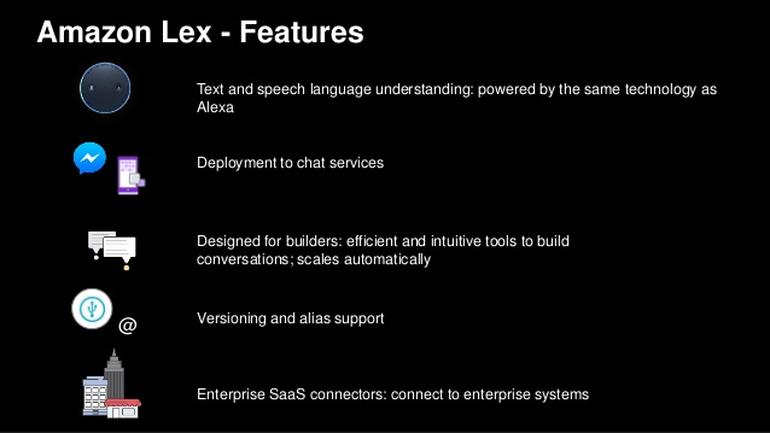Amazon Lex is the tech that powers Alexa, which is used in the Amazon Echo (above) and Fire TV.
Image: Amazon
With the rise of personal assistant chatbots, the tools required for organizations to build their own assistants are being moved to the cloud to give developers the ability to leverage these technologies in their products. Foremost among these tools is Amazon Lex, the speech recognition and natural language processing technology that powers the Alexa virtual assistant, used in the Amazon Echo speaker and Fire TV digital media player.
TechRepublic’s smart person’s guide to Amazon Lex is an introduction to the language processing technology. This “living” guide will be updated periodically as further integrations are released.
SEE: Check out all of the TechRepublic smart person’s guides
Executive summary
- What is Amazon Lex? Amazon Lex is a cloud-based automatic speech recognition and natural language comprehension service.
- Why does Amazon Lex matter? Amazon Lex can be used with other cloud services to create smart assistants for use with a specific task.
- Who does Amazon Lex affect? Businesses that need to automate customer support or transactional tasks can use Amazon Lex as a component of a custom chatbot in their organization.
- When is Amazon Lex released? Amazon Lex has been in development since 2010, though it only became available as an API for developers in November 2016.
- How do I get Amazon Lex? You can sign up for free trial access on the AWS website.
SEE: Special report: How to implement AI and machine learning (free PDF) (TechRepublic)
What is Amazon Lex?
Amazon Lex is the public-facing version of the technology that powers the automatic speech recognition (ASR) and natural language understanding (NUR) capabilities of Amazon’s Alexa assistant, found in Amazon and third-party hardware. Amazon Lex enables programs to process natural human language, allowing for more versatile means of interaction.

Image: AWS
Amazon Lex can be leveraged as part of the design for chatbots, which can cover a variety of use cases, including customer support, application / transactional bots (automating tasks such as placing an order or making a reservation), and as a control bot issuing and understanding commands for Internet of Things (IoT) devices.
Presently, Amazon Lex interaction can be exposed through other AWS services, or through Facebook Messenger, while support for Slack is forthcoming.
Note: Amazon Lex is for developing your own chatbot; it is a different product than the Alexa Skills Kit, which is for developers wanting to create an integration with the Alexa assistant found on smart home products.
Additional resources:
Why does Amazon Lex matter?
Amazon has released Lex alongside other artificial intelligence targeted services, including Amazon Polly, a natural text-to-speech engine that includes support for 17 languages, including English, French, Spanish, Germany, Japanese, and Portuguese, as well as support for regional accents and dialects (American, Australian, British, Indian, and Welsh English, Canadian French, Brazilian Portuguese, and American and Castilian Spanish). Polly can be integrated with other services and data sets for a variety of use cases, such as automated text-to-speech for reading written content, announcement systems for use in public or industrial settings, and for user feedback with IoT devices.
Amazon Lex and Amazon Polly can be used together to create smart assistants for specific use cases, such as telephone support systems. Amazon Lex, itself, leverages AWS Lambda for intent fulfillment, Amazon Cognito for user authentication, and Polly for text-to-speech synthesis.
Also released at the the same time is Amazon Rekognition, a deep-learning system capable of identifying characteristics of images, such as tagging objects, scenery, and faces. It can also identify the sentiments of faces (frown, smile, anger), and perform facial recognition.
Additional resources:
Who does Amazon Lex affect?
Businesses that need to automate routine customer support or transactional tasks can benefit by using Amazon Lex as a component of a custom chatbot in their organization.

Image: AWS
Chatbots are increasingly being used by many organizations to increase outbound lead generation as part of a strategy to boost sales. In the age of social media, the ability to increase brand engagement with consumers is paramount, and the utilization of chatbots adds a personalized touch to establishing a brand relationship, which can go a long way in developing positive sentiment for your organization.
Programmers have a variety of options for integrating Amazon Lex into their projects. Amazon provides SDKs for Android and iOS, which support text and speech input. Alternatively, text-only input can be processed using Java, JS, Python, CLI, .NET, Ruby, PHP, Go, or C++. By means of AWS Lambda, Amazon Lex can be integrated with the enterprise connectors Salesforce, Microsoft Dynamics, Marketo, Zendesk, QuickBooks, and HubSpot. For security purposes, all Amazon Lex transactions are communicated over HTTPS.
Presently, Amazon Lex is limited to support of US English.
Additional resources:
When is Amazon Lex happening?
Amazon Lex has been developed internally at Amazon since at least 2010, including companies that Amazon has acquired in the interest of developing this technology. The Amazon Echo speaker, the first product to support the Alexa personal assistant, was released in November 2014. Amazon Lex was released to the public, alongside other artificial intelligence products at the AWS re:Invent conference, in December 2016.
Pricing for Amazon Lex, as with other AWS services, is metered on a per-use basis. Each voice request is $0.004, while text requests are $0.00075. To illustrate, 1,000 voice requests are billed as $4.00, and 1,000 text requests are $0.75.
Additional resources:
Which products are Amazon Lex’s competitors?
Hewlett Packard Enterprise has a competing product, IDOL, which includes personalized knowledge discovery in addition to natural language processing. Google’s Natural Language Processing API is also a competent alternative to Amazon Lex, with support for English, Spanish, and Japanese.
Additional resources:
How do I get Amazon Lex?
It is easy to get started using Amazon Lex. Prospective users can sign up for the free preview program. Presently, Amazon Lex is only available in the US East AWS Region.
Additional resources:
